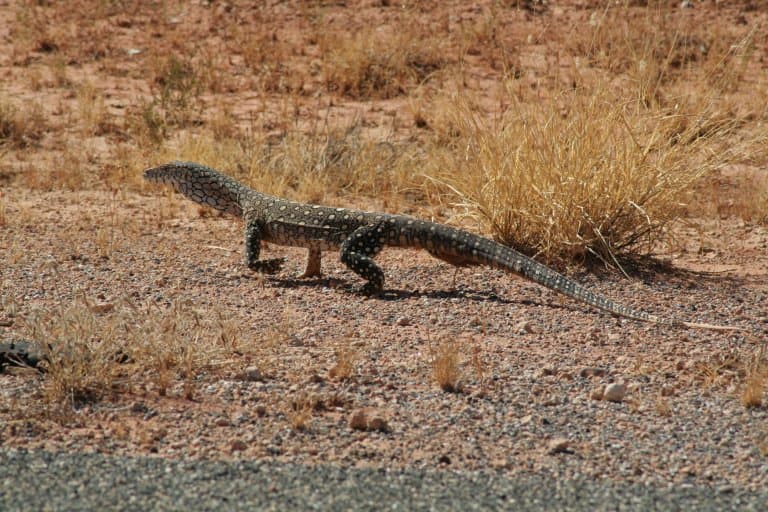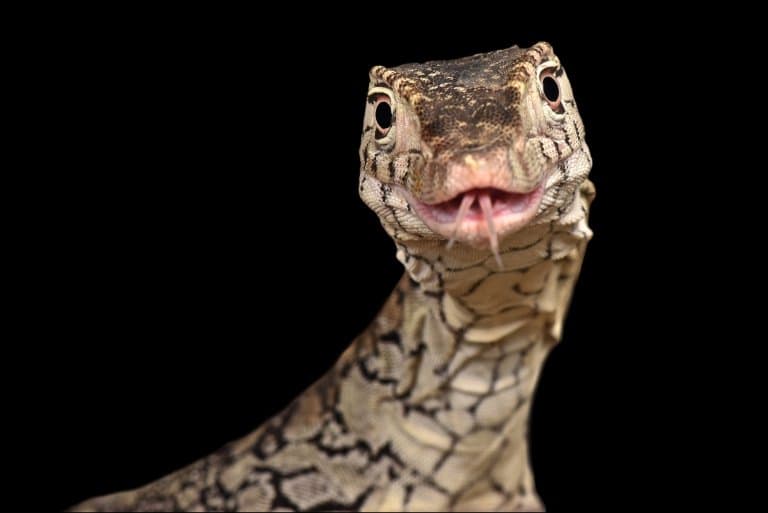Perentie Profile
Monitor lizards are just the best lizards. They’re hugely variable and successful animals that live all over the world.
They come in innumerable forms, across three continents from the sleek and nimble Nile monitor in Africa to the lumbering toxic monster from Komodo in Asia.
Australia has them, too. And of these, the Perentie is the largest monitor lizard.

Perentie Facts Overview
| Habitat: | Arid, semi-desert areas |
| Location: | Throughout the interior of Australia |
| Lifespan: | 30 years |
| Size: | 2.5 m (8 ft 2 in) long |
| Weight: | More than 20kg (44lb) |
| Colour: | Creamy yellow/orange with dappled black patterning |
| Diet: | Generalised small animal prey, carrion |
| Predators: | None |
| Top Speed: | Possibly up to 40km/h (25mph) |
| No. of Species: | 1 |
| Conservation Status: | Least Concern (IUCN) |
Perenties inhabit the arid deserts of western Australia. Despite their size of up to 2.5m (8ft 2), they are rarely seen by humans due to their remote location.
For something with such a cute name, Perenties are formidable predators.
These are lizards that are able to do things most reptiles can’t, and if a Perentie has its sights on something, there’s not a lot the hapless animal could do about it.
They are carnivores and will mostly feed on reptiles, small mammals and sometimes birds.
They can run, climb, dig, taste, see, hear, and think faster and better than most reptiles, and this makes them a top predator in the Australian desert landscape.
Interesting Perentie Facts
1. They’re very active
These are sleek, nimble lizards, similar in size and physiology to the Nile monitor. They have a high body temperature, allowing them to maintain energy outputs for longer, and are well-evolved at hunting and catching difficult prey.
And they’re not fussy in this regard. They’ll eat almost anything small enough to fit into their mouths. While most lizards can’t breathe and run at the same time, monitors separate the breathing and running muscles to accomplish this.
The increased body temperature does come with a trade-off that means they’ll need to eat a lot more often than a colder reptile like a crocodile, but they’re seemingly quite fine covering great distances in pursuit of food.
Energy levels are one thing that sets it apart from many reptiles, and this lizard is one of the fastest, but this is far from the only awesome adaptation this lizard possesses. 1 2
2. They’re the fastest reptile in the world
The perentie is able to run up to speeds of 40 kph (25 mph) which makes it not just the fastest lizard in the world, but the fastest reptile, and is included in our ‘fastest animals on earth‘ list.
They are extremely fast sprinters and run using either all four legs, or just their hind legs!
The animal is able to expand the side of its neck to pump large volumes of air into its lungs while running.
3. They’re venomous! Maybe
Venom is a weird topic. When we think of reptile venom, we typically imagine hollow fangs, fed from modified salivary glands containing a cocktail of proteins and often bacteria that can be directly injected into prey for dispatching it quickly.
And this is true, but it seems to represent the end of the spectrum of venom strategies. For example, not all fangs are hollow; this is a relatively new adaptation. And not all venom glands are as neatly isolated.
Primitive fangs are simply grooved teeth. And not all venoms are complex or specialised. Some don’t appear to be much use at disabling prey at all, and some just sort of dribble down the tooth from dental glands, as is the case in monitor lizards.
For an animal to be considered venomous, rather than simply toxic, the toxin has to have a function. If there’s no use for the damaging proteins dribbling over its teeth, it simply has a really gross bite.
Since monitors tend to catch their prey and rip it to pieces faster than any venom would have time to work, it’s uncertain what the use of the toxin is, if any. But if that toxin was enough to put off larger predators, it would have a function and could therefore be considered a venom.
So, the debate around monitor lizards’ potential venom continues, but the truth is, they’re certainly quite toxic as biters go. 3
4. They can smell with their tongue
As if a large, rapid and potentially venomous predator wasn’t intimidating enough, the Perentie has even more tricks up its sleeve.
This formidable attacker comes pre-packaged with advanced vision, hearing, taste and smell capabilities.
The chemoreception of monitor lizards is very acute – more in line with that of snakes – and their tongue is not used to manipulate food; instead, it is their primary olfactory organ. It’s cylindrical with a huge fork.
A forked tongue gives stereo inputs, much like the two nostrils on your face, or the ears on either side of your head. This means monitors can tell the direction of smells using only their tongues!
But with all this hardware, you might be thinking your best bet is to confuse the animal. But you’d be out of luck there, too. 4

5. They’re even smart
Your brain is said to take up a quarter of your daily calorie expenditure, despite making up around 2% of your weight. This is a testament to just how much energy we need to be able to think. 5
That’s why complex intelligence doesn’t exist in every avenue of life’s evolution – it’s just too expensive to have it where it’s not required.
Cold-blooded reptiles likely don’t spend a lot of time pondering things on account of their slow metabolism and low body temperature. But as we mentioned, the Perentie is a hot sprinter with a lot of sensory adaptations.
This is considered one of the smartest lizards there is. They’re quick to train and are naturally curious animals who need plenty of enrichment in captivity to keep them mentally stimulated.
6. They fight
So, if you’re unlucky enough to be on the Perentie’s radar, it seems like there isn’t much you could do about it. Fortunately, humans are far too large to be considered prey, even for the 2.5-meter perenties, who still much prefer smaller animal food.
However, they are commonly seen battling it out with their competition.
Fights between perenties can last over 20 minutes and are gruelling, bloody battles that make use of long tails, sharp teeth, and powerful digging claws.
Their large necks, which they inflate as bellows for breathing, also get used as a threat display during these sessions, but if threats don’t work, the loser can come off badly hurt. 6

7. And they dig
Those huge claws are mostly put to use digging burrows, which they can do in a matter of minutes.
Burrows are large and deep, and often complex, with more than one entry or emergency exit. They’re often made under something heavy like a boulder, and females will lay eggs inside such a tunnel system, which will hatch 2-3 months later.
Sometimes, they’ll be seen making use of the intricate air conditioning systems inside termite mounds to dig out a home that’s just the right temperature.
These digging claws also aid them in tree climbing, which further reduces the number of ways the prey of this animal can escape! 7
8. They are cannibals
Perentie are will eat other lizard species, but they will also eat smaller members of their own species. 2m long perenties have been witnessed eating 1.5m long perenties in acts of cannibalism.
Prey is often swallowed whole when small enough in size, but when larger chunks are ripped off to make swallowing more manageable. They are able to take down prey as large as kangaroos, which they will dismemeber using their sharp claws.
Perentie Fact-File Summary
Scientific Classification
| Kingdom: | Animalia |
| Phylum: | Chordata |
| Class: | Reptilia |
| Order: | Squamata |
| Family: | Varanidae |
| Genus: | Varanus |
| Sub Genus: | Varanus |
| Species: | Varanus Giganteus |
Fact Sources & References
- JONATHAN B. LOSOS (2008), “Ecological and evolutionary implications of diet in monitor lizards”, Oxford Academic.
- GlobalZoo (2013), “The Perentie”, Youtube.
- Dr. Timothy Jackson (2020), “Are monitor lizards venomous? (the Tale of Toxicofera, part 4)”, University of Melbourne.
- Steve Wilson (2012), “Australian Lizards: A Natural History”, CSIRO Publishing.
- Lone Pine Koala Sanctuary (2020), “Behind-the-scenes of Perentie Cam”, Youtube.
- (2021), “Perenties fight to (near) death”, Australian Geographic.
- “Perentie”, Reptile Park.
